Coconut : Crop Imorovement
Major achievements of research
A. Varieties/ hybrids released by the AICRP on palms for commercial cultivation in different agro climatic regions.
Kamrup
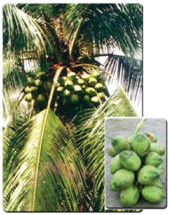 The variety recorded more than 100 nuts/palm/year, tolerant to low temperature and semi-waterlogged condition, tolerant to stem bleeding, red palm weevil, crown choking and grey leaf spot. Better nut quality with 253 ml of tender nut water, copra yield: 2.86 tonnes/ ha, oil content: 64.5 %. Adaptable to wide range of soil and highly accepted by the farmers.
The variety recorded more than 100 nuts/palm/year, tolerant to low temperature and semi-waterlogged condition, tolerant to stem bleeding, red palm weevil, crown choking and grey leaf spot. Better nut quality with 253 ml of tender nut water, copra yield: 2.86 tonnes/ ha, oil content: 64.5 %. Adaptable to wide range of soil and highly accepted by the farmers.
Recommended for Assam state.
Gauthami Ganga
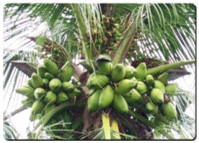 It is a selection from the local early bearing germplasm accession, Gnagabondam, with an average nut yield of 80 to 90 nuts/palm/year. Dwarf palm with semi circular canopy with oblong shaped green colour fruits. Yields 12813 nuts/ha/year with copra content of 156.7g/nut and an oil content of 68%.
It is a selection from the local early bearing germplasm accession, Gnagabondam, with an average nut yield of 80 to 90 nuts/palm/year. Dwarf palm with semi circular canopy with oblong shaped green colour fruits. Yields 12813 nuts/ha/year with copra content of 156.7g/nut and an oil content of 68%.
Recommended for Chhattisgarh, Andhra Pradesh, Maharashtra and Tamil Nadu states.
Kera Bastar
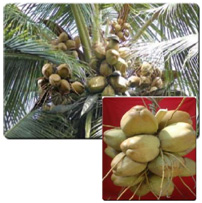 It is selection from Fiji Tall and excellent coconut variety with wide adaptability. The nut yield ranges from 110 to 117 nuts/palm/year with a copra yield of 2.5 to 3.1 tonnes/ha. Widely adapted to different agro- climatic zones. Quantity of tender nut water is 332ml and total sugar content in tender nut is 6.2g/100 ml.
It is selection from Fiji Tall and excellent coconut variety with wide adaptability. The nut yield ranges from 110 to 117 nuts/palm/year with a copra yield of 2.5 to 3.1 tonnes/ha. Widely adapted to different agro- climatic zones. Quantity of tender nut water is 332ml and total sugar content in tender nut is 6.2g/100 ml.
Recommended for Chhattisgarh, Andhra Pradesh, Maharashtra and Tamil Nadu states.
Kalyani Coconut-1
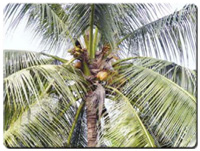 A selection from Jamaican Tall, comes to bearing by 72 months. It gives 14066 nuts/ha/year with an average yield 80 nuts/palm/year.The copra contents is 154 g/nut with copra yield of 12.3 kg/palm/year. Tender nut quality of the variety is good with 350 ml of water, 4.9 % of total sugar content and high potassium (2347 ppm) content.
A selection from Jamaican Tall, comes to bearing by 72 months. It gives 14066 nuts/ha/year with an average yield 80 nuts/palm/year.The copra contents is 154 g/nut with copra yield of 12.3 kg/palm/year. Tender nut quality of the variety is good with 350 ml of water, 4.9 % of total sugar content and high potassium (2347 ppm) content.
Recommended for West Bengal state.
Kera Keralam
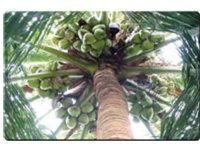 It is a selection from the popular local accession of west coast region of India, viz., West Coast Tall. It is a tall coconut variety. It is found to be promising and adaptive to wide ranging cultivation zones; comes to flowering in 58 months. Yields 147 nuts/palm/year with irrigation. In east coast region of Tamil Nadu, it recorded higher nut yield by 19 to 48 % over the previously released varieties. It comes up well in varied types of soil including sandy, sandy loam and red sandy loam with pH ranging from 6.0 to 8.0.
It is a selection from the popular local accession of west coast region of India, viz., West Coast Tall. It is a tall coconut variety. It is found to be promising and adaptive to wide ranging cultivation zones; comes to flowering in 58 months. Yields 147 nuts/palm/year with irrigation. In east coast region of Tamil Nadu, it recorded higher nut yield by 19 to 48 % over the previously released varieties. It comes up well in varied types of soil including sandy, sandy loam and red sandy loam with pH ranging from 6.0 to 8.0.
Recommended for states of Kerala, Tamil Nadu andWest Bengal.
Hybrids released by AICRP
Konkan Bhatye Coconut Hybrid-1
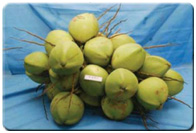 It is a cross between GBGD x ECT and released in the
year 2007, tall palm with semi- circular bearing at 66 months with green colour oval shaped fruit. It is a high yielder with better copra quality than West Coast Tall and Pratap and with better oil content than ECT (67.10%). This hybrid yields 122 nuts/palm/year (20300 nuts/ha/ year) with copra yield of 22.08 kg/palm/year i.e. 3.43 tonnes/ha/year. It is resistance to stem bleeding diseases and moderately resistance to leaf blight and bud rot.
It is a cross between GBGD x ECT and released in the
year 2007, tall palm with semi- circular bearing at 66 months with green colour oval shaped fruit. It is a high yielder with better copra quality than West Coast Tall and Pratap and with better oil content than ECT (67.10%). This hybrid yields 122 nuts/palm/year (20300 nuts/ha/ year) with copra yield of 22.08 kg/palm/year i.e. 3.43 tonnes/ha/year. It is resistance to stem bleeding diseases and moderately resistance to leaf blight and bud rot.
Recommended for Maharashtra.
Godavari Ganga
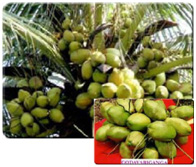 This is a hybrid from East Coast Tall x Gangabondam.The average yield is 140 nuts/tree. Average yield ofcopra 153 g/nut having oil content 67%.
This is a hybrid from East Coast Tall x Gangabondam.The average yield is 140 nuts/tree. Average yield ofcopra 153 g/nut having oil content 67%.
Recommended for Andhra Pradesh state.
Vasista Ganga
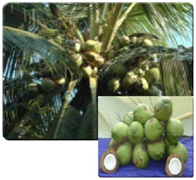 This is a hybrid GBGD x PHOT found promising based on its precocity, higher nut yield (125 nuts/palm/year), copra output (21.9 kg/palm/year), oil content (69% and oil yield 15.1 kg/palm/year) with good tender nut water content (395 ml) and TSS (6.20Brix).
This is a hybrid GBGD x PHOT found promising based on its precocity, higher nut yield (125 nuts/palm/year), copra output (21.9 kg/palm/year), oil content (69% and oil yield 15.1 kg/palm/year) with good tender nut water content (395 ml) and TSS (6.20Brix).
Recommended for Andhra Pradesh and Karnataka states.
Anantha Ganga
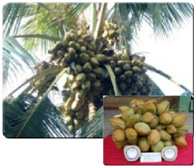 The coconut hybrid GBGD x LCOT is high yielding, precocious; having heavy bunches with average nut yield (128 nuts/ palm/year), copra output 21.7 kg/palm/year, oil content 72 % and oil yield 15.5 g/palm/year).
The coconut hybrid GBGD x LCOT is high yielding, precocious; having heavy bunches with average nut yield (128 nuts/ palm/year), copra output 21.7 kg/palm/year, oil content 72 % and oil yield 15.5 g/palm/year).
Recommended for states of Andhra Pradesh and Karnataka.
Kalpa Ganga
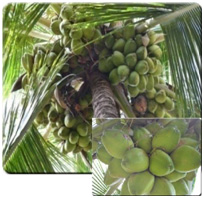 Hybrid GBGD x FJT gives higher nut yield of 120 nuts/palm/year. Copra out turn of 3386 kg /ha.Short stature and suitable for ball copra production.Relatively tolerant to major pest and diseases, Hybrid is having high potential with wider adoptability would help to enhancing the coconut productivity in Karnataka.
Hybrid GBGD x FJT gives higher nut yield of 120 nuts/palm/year. Copra out turn of 3386 kg /ha.Short stature and suitable for ball copra production.Relatively tolerant to major pest and diseases, Hybrid is having high potential with wider adoptability would help to enhancing the coconut productivity in Karnataka.
Recommended for Karnataka state.
Varieties/Hybrids released jointly by AICRP on Palms and CPCRI
Kalpa Dhenu
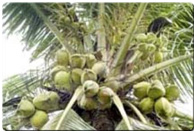 It is a regular bearer, relatively tolerant to drought. The palms are tall, robust and bear large, green nuts. The tender nut water of this variety contains 4.92g total sugars/100 ml, 1.3 mg free amino acids/100 ml, 2650 ppm potassium and 24.6 ppm sodium. It commences flowering in 67 months after planting. The quantity of tender nut water is 290 ml/nut.. It produces an average yield of 15012 nuts/ha, copra yield of 37 q/ha and oil yield of 24 q/ha.
Recommended for Kerala, Karnataka, Maharashtra, Tamil Nadu and Andaman & Nicobar Islands.
It is a regular bearer, relatively tolerant to drought. The palms are tall, robust and bear large, green nuts. The tender nut water of this variety contains 4.92g total sugars/100 ml, 1.3 mg free amino acids/100 ml, 2650 ppm potassium and 24.6 ppm sodium. It commences flowering in 67 months after planting. The quantity of tender nut water is 290 ml/nut.. It produces an average yield of 15012 nuts/ha, copra yield of 37 q/ha and oil yield of 24 q/ha.
Recommended for Kerala, Karnataka, Maharashtra, Tamil Nadu and Andaman & Nicobar Islands.
Kalpa Pratibha
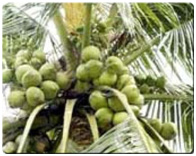 It is suitable for tender nut and copra. The variety is a regular bearer, relatively tolerant to drought. The nuts are large, round in shape and predominantly green in colour.The quality of tender nut water is good with 5.5 g total sugars/100ml, 1.1 mg free amino acids/100 ml, 2150 ppm potassium and 21.7 ppm sodium.The quantity of tender nut water is 448 ml/ nut. It produces an average yield 15874 nuts/ha, copra yield of 41 q/ha and oil yield of 27 q/ha.
It is suitable for tender nut and copra. The variety is a regular bearer, relatively tolerant to drought. The nuts are large, round in shape and predominantly green in colour.The quality of tender nut water is good with 5.5 g total sugars/100ml, 1.1 mg free amino acids/100 ml, 2150 ppm potassium and 21.7 ppm sodium.The quantity of tender nut water is 448 ml/ nut. It produces an average yield 15874 nuts/ha, copra yield of 41 q/ha and oil yield of 27 q/ha.
Recommended for Kerala, Karnataka, Maharashtra and Tamil Nadu states.
Kalpa Mitra
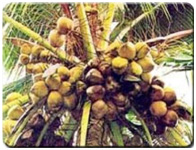 It is a regular bearer, relatively tolerant to drought and produces large, yellowish green, oval shaped nuts. The variety is suited for west coast region of the country and West Bengal. Suitable for ball copra. The tender nut water of this variety contains 5.7g total sugars/100 ml, 1.3 mg free amino acids/100ml, 2150 ppm potassium and 23.5 ppm sodium. The quantity of tender nut water is 495 ml. It produces an average yield of 13973 nuts/ha, copra yield of 34 q/ha and oil yield of 22 q/ ha.
It is a regular bearer, relatively tolerant to drought and produces large, yellowish green, oval shaped nuts. The variety is suited for west coast region of the country and West Bengal. Suitable for ball copra. The tender nut water of this variety contains 5.7g total sugars/100 ml, 1.3 mg free amino acids/100ml, 2150 ppm potassium and 23.5 ppm sodium. The quantity of tender nut water is 495 ml. It produces an average yield of 13973 nuts/ha, copra yield of 34 q/ha and oil yield of 22 q/ ha.
Recommended for states Kerala, Karnataka, Maharashtra, Tamil Nadu and West Bengal.
Kalpataru
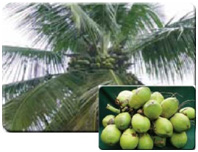 It is a selection from Tiptur Tall accession, suitable for ball copra production. The average yield of 20300 nuts/ ha, copra yield of 35 q/ha and oil yield of 25 q/h.
It is a selection from Tiptur Tall accession, suitable for ball copra production. The average yield of 20300 nuts/ ha, copra yield of 35 q/ha and oil yield of 25 q/h.
Recommended for rain fed and irrigated regions of Karnataka, Tamil Nadu and Kerala states.
Kalpa Samrudhi
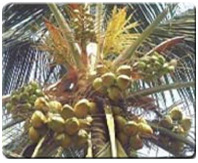 A hybrid coconut MYDxWCT (Kalpa Samrudhi) has also been emerged out as high yielder (104 nuts/palm/year) with higher copra out turn (3.1 t/ha) and oil content (68.0%) has been recommended for release for the region by AICRP on Palms, Kahikuchi centre in collaboration with CPCRI, Kasaragod. The hybrid is semi-tall, precocious bearing (comes to bear at 5 years) moderately tolerant to stem bleeding, red palm weevil and crown choking disorder.
A hybrid coconut MYDxWCT (Kalpa Samrudhi) has also been emerged out as high yielder (104 nuts/palm/year) with higher copra out turn (3.1 t/ha) and oil content (68.0%) has been recommended for release for the region by AICRP on Palms, Kahikuchi centre in collaboration with CPCRI, Kasaragod. The hybrid is semi-tall, precocious bearing (comes to bear at 5 years) moderately tolerant to stem bleeding, red palm weevil and crown choking disorder.
Recommended for Kerala and Assam states.
Kalpa Jyothi
 Dwarf variety with yellow fruits, higher average yield of 114 nuts per palm per year under rainfed conditions with estimated copra yield of over 16 kg per palm per year.
Dwarf variety with yellow fruits, higher average yield of 114 nuts per palm per year under rainfed conditions with estimated copra yield of over 16 kg per palm per year.
Recommended for cultivation in Kerala and Karnataka for tender nut purpose.
Kalpa Surya
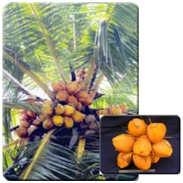 Dwarf with Orange fruits for tender nut purpose. The average yield is 123 nuts per palm per year under irrigated conditions with estimated copra out turn of 23 kg per palm per year.
Dwarf with Orange fruits for tender nut purpose. The average yield is 123 nuts per palm per year under irrigated conditions with estimated copra out turn of 23 kg per palm per year.
Recommended for cultivation in Kerala, Karnataka and Tamil Nadu state.
Kalpa Shresta
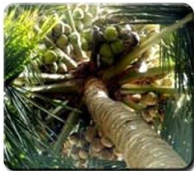 The mean yield is 167 nuts/palm/year, with estimated high copra out turn of 35.9 kg/palm/year or 6.28t/ha copra. The hybrid is suitable for tender nut purpose; ball copra purpose also.
The mean yield is 167 nuts/palm/year, with estimated high copra out turn of 35.9 kg/palm/year or 6.28t/ha copra. The hybrid is suitable for tender nut purpose; ball copra purpose also.
Recommended for Kerala and Karnataka States.
Nucleus seed gardens for the ten recently released coconut varieties were established at the respective State Coconut Research Stations to meet the demands of quality planning material requirement.
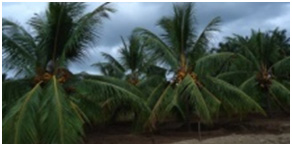 |
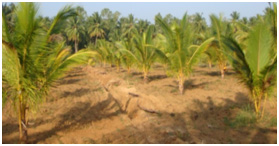 |
| COD seed garden at Aliyarnagar | Kenthali seed garden at Aliyarnagar |
Details of nucleus seed garden establishment:
| Sl. No | centres | Nucleus seed garden for released varieties |
| 1 | Aliyarnagar ( Tamil Nadu) |
Aliyarnagar Tall, COD, MGD, MYD and Kenthali Dwarf, Kalpa Pratibha, Kera Keralam |
| 2 | Veppankulam ( Tamil Nadu) |
Kera Keralam, Kalpa Pratibha |
| 3 | Ambajipeta ( Andra pradesh) |
Gautami Ganga, Kalpa Pratibha |
| 4 | Jagdalpur (Chhattisgarh) |
Kera Bastar |
| 5 | Kahikuchi (Assam) |
Kamrupa |
| 6 | Mondouri (West Benagl) |
Kalyani Coconut 1, Kalpa Mitra, Kera Keralam |
| 7 | Ratnagiri ( Maharashtra) |
Gautami Ganga, East Coast Tall, Kera Bastar |
A total of 112 ecotypes of coconut have been collected from Assam, Chhattisgarh, Odisha, W.B., Karnataka, Tamil Nadu, A.P. and Maharashtra for desired traits and conserved for further evaluation.
| Sl. No | centres | Local Germplasm assembled |
| 1 | Aliyarnagar | 13 |
| 2 | Ambajipeta | 13 |
| 3 | Arsikere | 20 |
| 4 | Bhubaneshwar | 11 |
| 5 | Jagdalpur | 6 |
| 6 | Kahikuchi | 15 |
| 7 | Mondouri | 10 |
| 8 | Navsari | 4 |
| 9 | Ratnagiri | 13 |
| 10 | Veppankulam | 7 |
| Total | 112 | |
Elite mother palms have been identified in different agro climatic regions for collecting seed nuts and further quality seedling production and distribution to farmers.
| Sl. No | States/ Districts | Elite mother palms identified (Nos) |
| Tamil Nadu | ||
| 1 | Coimbatore | 1000 |
| 2 | Erode | 1000 |
| 3 | Tirupur | 1000 |
| 4 | Thanjavur | 1000 |
| Andhra Pradesh | ||
| 5 | East Godavari and West Godavari dt | 1500 |
| Maharashtra | ||
| 6 | Ratnagiri | 1000 |
| 7 | Raigad | 1000 |
| Assam | ||
| 8 | Kamrap | 200 |
| 9 | Nalbari | 200 |
| 10 | morigoan | 200 |
| 11 | Nagaon | 200 |
| Chhattisgarh | ||
| 12 | Bastar region | 70 |
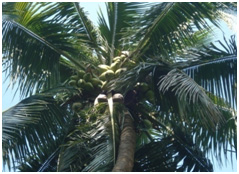 |
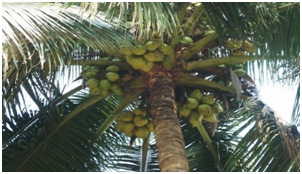 |
| Elite mother palms identified in Kamrup and Nalbari dt. of Assam | |
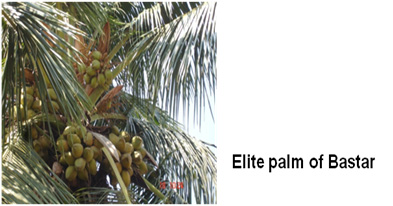
Evaluation of varieties / hybrids for higher yield
- Evaluation of Tall x Tall coconut hybrids - Five T x T hybrids viz., LCOT x ADOT, ADOT x ECT, BGR x ADOT, ECT x LCOT, WCT x TPT + local check have been planted at Aliyarnagar, Ambajipeta, Arsikere, Bhubaneshwar, Kahikuchi, Navsari, Ratnagiri and Veppankulam.
- Location specific Tall x Tall hybrids (12 crosses) with wider adaptability have been planted in eight AICRP centres for their evaluation.
- Region-specific Dwarf x Dwarf hybrids (5 crosses) produced for dwarfness, tender coconut yield and early flowering have been planted for evaluation in five AICRP centres (Ambajipeta, Mondouri, Ratnagiri, Veppankulam and Pilicode). Five D x D hybrids (COD x MYD, COD x MGD, MYD x CGD, GBGD x MOD, CGD x MGD) + 1 local check were tested.
9.1.2 Oil palm
Gangavathi
- The FFB yield over a period of 10 years from 1998-99 to 2007-08 revealed that the combination 109 D x 291 P performed significantly superior to other combinations in 6 out of 10 years and remained numerically superior in other years indicating the consistency of the hybrid. The progeny recorded 16.41 and 15.09 t/ha during 2007 and 2008, respectively which was significantly superior to other hybrids. The next best progeny was 148 D x 98 P with FFB yield of 12.67 and 11.77 t/ha during 2007 and 2008, respectively. The higher FFB yield in the case of 109 D x 291 P was mainly attributed to more number of bunches, and significantly higher mean bunch weight as well as presence of more number of fruits per bunch. The economics revealed that the hybrid 109 D x 291 P recorded higher net returns of Rs. 57013/ha and 51043/ha during 2007 and 2008, respectively followed by 148 D x 98 P with a net returns of Rs. 4 0168 and 36133/ha, respectively during the same period.
Evaluation of oil palm genotypes for drought tolerance
- The FFB yield differed significantly among the various genotypes. The genotype ZS-3 recorded significantly higher mean FFB yield of 9.11 t/ha over all other genotypes.
- The five genotypes (ZS-3-R-3-3), (ZS-1-R-3-2), (ZS-6-R-2-2), (ZS-3-R-2-6) and (TS-5- R-3-3) are selected as mother palms for crossing programme to find out best cross combination (Hybrid).
- Under Evaluation of oil palm genotypes for drought tolerance, it was observed that, based on last 10 years data analysis, five African dura genotypes viz., ZS-3, ZS-1, ZS-6, ZS-3 and TS-5 were identified as drought tolerance based on physiological and yield characters and are further selected as mother palms for crossing programme to improve the dura types and dura x pisifera crosses.
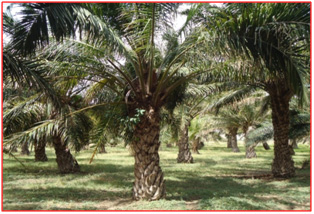 |
| General view of drought tolerance study at Gangavati |
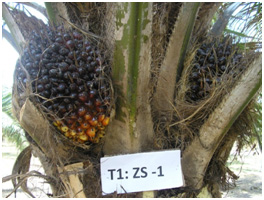 |
| ZS 1 genotype |
Evaluation of Tenera hybrids
- Ten new oil palm hybrids developed from DOPR, Regional Station, Palode were planted during 2007 by adopting RBD with 3 replications and 6 palms per treatment. During, 2013-14, the hybrid NRCOP-4 recorded the significantly higher mean FFB yield (10.61t/ha) and was on par with NRCOP 1 (10.1 t/ha) and NRCOP 2 (10 t/ha) and differed significantly over hybrids like NRCOP-3 (5.95 t/ha) and NRCOP-6 (7.31 t/ha).
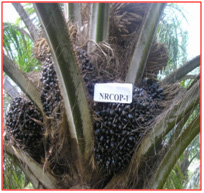 |
 |
| Yield of NRCOP1 and 4 at Gangavathi | |
Evaluation of new cross combinations in oil palm
The FFB yield differed significantly among the various hybrids. The hybrid NRCOP-4 (10.61t/ha) recorded the significantly higher mean FFB yield over NRCOP-3 (5.95 t/ha) and NRCOP-6 (7.31 t/ha) and it was on par with remaining hybrids.
The genotype NRCOP-4 was recorded good yield levels during last three years.
Progeny evaluation trial in oil palm
The hybrids NRCOP-37 & NRCOP-32 performing better as compare to other hybrids with respect to the vegetative growth parameters at Gangavati centre.
Mulde:
- Hybrid combination 148 D X 98 P (V9) recorded significantly higher yield of FFB ( 96.20 kg/palm and 13.75 t/ha)
- Hybrid combination 124 D X 266P (V4) recorded 154.86 kg/palm and 22.16 t/ha yield of FFB. Considering the performance of both the hybrids for last 10 years these hybrids identified as a promising hybrids.
- Among the African Dura type’s, ZS-2, ZS- 6, ZS-8, TS- 2, TS- 10 and TS -11 found to be drought resistant.
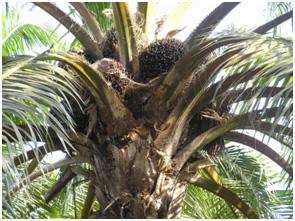 |
| ZS 6 genotype |
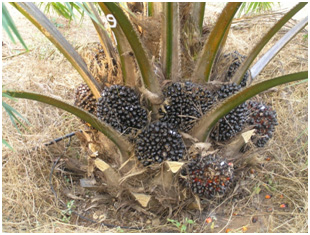 |
| NRCOP 9 hybrid |
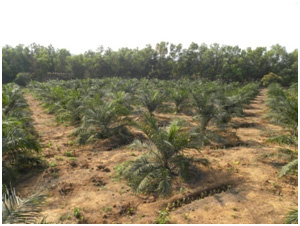 |
| General view of hybrid evaluation trial |
Pattukkotai:
- Of 10 hybrids (NRCOP 1 – NRCOP 10) studied for growth and yield parameters, data on yield attributes revealed that the highest FFB yield(81.79 kg/tree) was recorded in the hybrid NRCOP 5.
- Among the hybrids, data on yield attributes revealed that the highest FFB yield (135.5 kg/tree) and yield / ha (19.4 t) was registered in the hybrid NRCOP 17 at the age of 7 years in the farmers’ field.
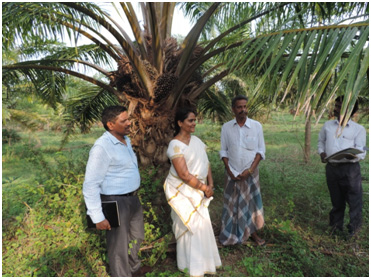 |
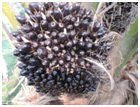 |
| Performance of hybrids in the farmer field | |
Vijayarai
- Out of 11 cross combinations tried at Vijayarai centre, 115D x 291P recorded maximum FFB yield of 22.6 t/ha from the varietal trial, which was recommended to the farmers for adoption.
- The Costa Rica hybrid developed at Palode centre performed well with an FFB yield of 15.5 t/ha among other cultivars (Papua New Guinea, IRHO & Costa Rica) like exotic Tenera hybrids at Vijayarai centre.
- Under hybrid evaluation trails, the hybrid NRCOP-4 produced highest yield of fresh fruit bunches (18.33 t/ha) and lowest in NRCOP-7 (8.24 t/ha) at the age of 7 years.
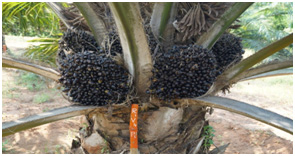 |
| NRCOP 4 hybrid |
9.1.3. Palmyrah
Pandirimamidi
- Germplasm collection was initiated at the center in the year 1991 adopting important selection indices such as leaf number, leaf area, plant height, fruit yield, neera yield and earliness etc. So far 284 accessions have been collected from various places and planted at the research station and evaluation is being continued.
| Sl. No | Year of Collection | State | district | No.of Accessions |
| 1 | 1991 | Andhra Pradesh | East Godavari | 13 |
| 2 | 1993 | Andhra Pradesh | East Godavari | 10 |
| 3 | 1994 | Andhra Pradesh | East Godavari | 14 |
| 4 | 1995 | Andhra Pradesh | East Godavari | 14 |
| 5 | 1998 | Andhra Pradesh | East Godavari | 8 |
| 6 | 1999 | Andhra Pradesh | East Godavari | 8 |
| 7 | 2000 | Andhra Pradesh | East Godavari | 18 |
| 8 | 2001 | Andhra Pradesh | Nellore | 45 |
| 9 | 2002 | Telangana | Nalgonda | 18 |
| 10 | 2002 | Tamil Nadu | Thoothukudi and Tirunelveli | 16 |
| 11 | 2003 | Andhra Pradesh | West and East Godavari | 13 |
| 12 | 2004 | Tamil Nadu | Thoothukudi and Tirunelveli Districts | 14 |
| 13 | 2006 | Andhra Pradesh | Vizag and East Godavari | 14 |
| 14 | 2007 | Tamil Nadu | Madurai and Tirunelveli and Virudnagar | 12 |
| 15 | 2008 | Tamil Nadu | Salem | 9 |
| 16 | 2009 | Andhra Pradesh | Srikakulam | 9 |
| 17 | 2010 | Bihar | Bhagalpur | 13 |
| 18 | 2011 | Andhra Pradesh | Guntur and Prakasam | 15 |
| 19 | 2012 | Andhra Pradesh | Nellore | 9 |
| 20 | 2013 | Karnataka | South Kanna | 7 |
| 21 | 2014 | Odisha | Puri and Khurdha | 5 |
| Total accessions | 284 | |||
VARIABLITIES OBSERVED DURING GERMPLASM SURVEY
Apart from normal variablities like fruit characters, leaf characters, palm height and stem girth etc., 3 different kinds of variability have been noticed during the course of survey.
A) Branching:- Different patterns of branching was observed in Palmyrah. The first type is branching at crown level giving out a rosette appearance having multiple crowns. This particular phenomena was first noticed at Vallivilai in Tamilnadu and subsequently at Gokavaram and Tuni areas of Andhra Pradesh. The number of leaves produced in this type of branching is almost 2 to 3 times to the normal ones. Second type of branching was emergence of small stem like structures in clusters on the stem. This was noticed in Nellore District of Andhra Pradesh. And the third kind of branching is very distinctive one where each palm is producing two stems and 3 stems. This was observed in the agency are of East Godavari during 2001. No fruits could be collected from these Palms as some of them were males and the others are at juvenile stage. Over all branching phenomena appears to be beneficial as the leaf production is high which can be better utilized in leaf based industries.
B). Stone Less Fruits:- During survey in Nellore District in 2001 a tree was identified producing stone less fruits. It is high fruit yielder and having a unique character of producing fruits round the year. This feature will be very useful in sectors where fruit is the main economic for making value added products. Since fruiting is round the year there is an additional advantage of tapping the tree year round.
C). Monocious Palm:- During the surveys a palm was identified producing both male and female spadices in addition with modified male spikes. These spike are swollen (24Cm) and enlarged (80Cm) and have small seed less fruits numbering 80 to 300 all along. The fruits are embedded and the modified spikes in the manner the seeds arranged in maize cob. Fruits in the normal fruit bunches are mostly 2 to 3 seeded and are black in colour. The reason for appearance of 3 kinds of floral bodies on the same palm is not known. This could probably be due to natural mutations.
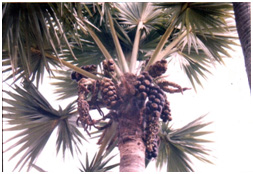
Killilulam:
- Collection of elite germplasm of palmyrah is being done since from 1995. Dwarf, early and high neera yielding genotypes alone are selected through surveys conducted both in Tamil Nadu and Andhra. The districts viz; Nalgonda in 2002, Sagallu in 2003, East Godavari and Nallampalli in 2006 and Srikakulam in 2009 were targeted in Andhra Pradesh. Similarly, the districts viz; Thoothukudi, Ramanad and Pudukottai in 2004,Tirunelveli and Virudhunagar in 2007,Salem in 2008,Srikakulam district of A.P during 2009 and Baghalpur & Banka districts of Bihar during 2010 and Prakasam and Guntur districts of A.P during 2011 and Nellore district of A.P during 2012 were surveyed jointly. Germplasm survey of palmyrah was conducted at South Kanara and Udipi districts of Karnataka during 2013. Survey was also carried out in Puri and Khorda district of Orissa and six germplasm lines were assembled and planted. As a result, 260 accessions have been collected and are being maintained at Killikulam centre since from the inception of the project. The accessions are being evaluated regularly for the growth and yield parameters every year.
Growth and development of palmyrah:
- The accessions are being evaluated regularly for the parameters such as plant height, stem girth, number of leaves, lamina length, lamina breadth and petiole length. In the year 2005-06 flowering was for the first time observed in the germplasm block of 1991. Subsequently the germ plasm blocks of 1993, 1994 and 1995 came to flowering during the later years and particulars of the inflorescences growth parameters have been recorded. Tapping was initiated on the palms and in the first year of flowering neera out flow was very poor and negligible and in the subsequent years the neera out flow was increased. Studies are under progress for identification of dwarf and high neera yielding palms among the existing germplasm which came to flowering.
- Under Growth and development studies recorded the growth data i.e. rate of leaf emergence, leaf length , petiole growth rates in seedling [2006 block] and Juvenile phase palms [2003 block] and adult phase palms [1991 Block]. From the results, it is evident that the growth rate of leaf as well as stalk was faster as the stage of growth advanced since the seedling stage experienced the lowest values for the above characters followed by Early Juvenile, Juvenile and adult stages. Among the male and female of adult trees higher values were recorded in male than female.
- For studying the germination pattern in palmyrah, seeds were collected from three different agro climatic regions in the district namely i.e., from dry tracts, wetland grown trees and from trees growing in the coastal areas and planted in beds. Beds have been pot watered initially for the fifteen days. Time taken for emergence of plumule from stone varied from 10 to 15 days among different stones irrespective to the collection origin. Further, it was observed that time taken for maximum tuber development also varied among the seeds from 99 to 104 days. Mean length of apocolon and tuber and width of tuber at full maturity was 46.7, 26.5 and 9.4 cm respectively.
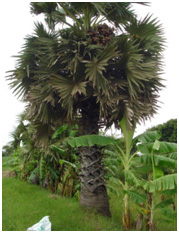
Dwarf statured palm collected from nellore (Andhra Pradesh) during 2012
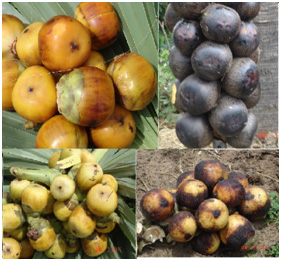
Fruit colour variation among the germplasm collected from Guntur and Prakasam districts (Andhra Pradesh) during 2011
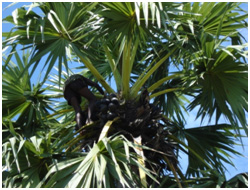
Germplasm from Tamil Nadu
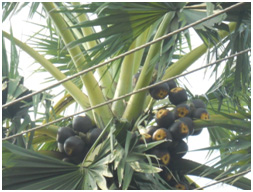
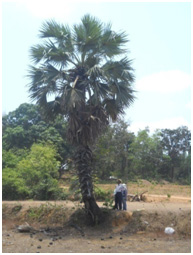
Germplasm from Bihar
 |
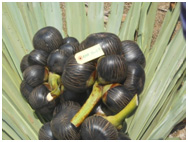 |
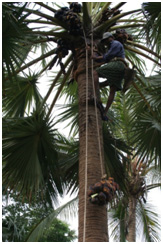 |
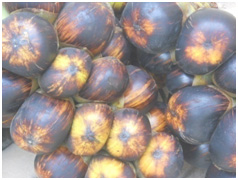 |
| Germplasm from Karnataka | |
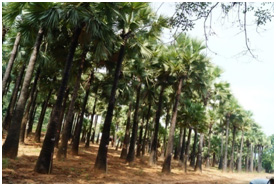 |
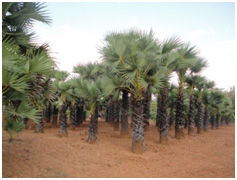 |
| Germ plasm block (1991-92 planted) | Germ plasm block (1998 planted) |
| Palmyrah germplasm block at Pandirimamidi | |
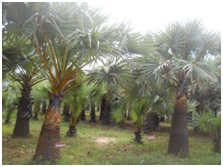 |
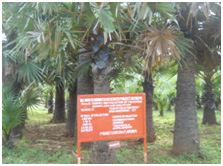 |
| Germplasm block at Killikulam | |
9.1.4. Sulphi palm
Among the most fascinating plants of diverse Bastar ecology the “Sulphi palms” has unique place in livelihood of tribal farmers. This palm is considered to be indigenous to India, Ceylon and Malaya and is found lave number in forest regions of western and eastern coasts and in the cool and shady valleys of Chhota Nagpur, Orissa, North Bengal and Assam. Sulphi (Caryota urens L.) belongs to the family palmaceae. The fiber of the leaf sheaths is used. The inflorescence is tapped for toddy. Sulphi is nurtured like a baby by tribal farmers of Bastar, which show it importance. Hear, it is grown in homestead gardens for plenty sap is knows as “Bastar beer” and one of the most important sources of earning income. Bastar beer is also very popular among the tourists visiting in this region. It is estimated that tribal farmer earns Rs. 25-30 thousand per year from single plant. Based on the importance of sulphi palm in the bastar region collection, conservation and evaluation of sulphi germplasm has been started from 2009.
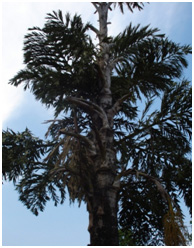 |
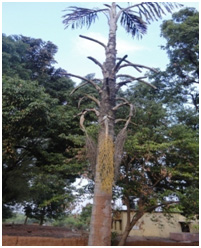 |
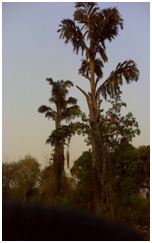 |
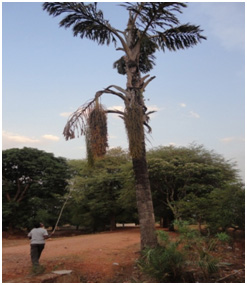 |
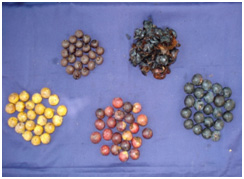 |
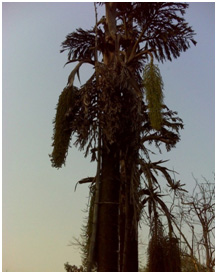 |
| SULPHI GERMPLASM | |
